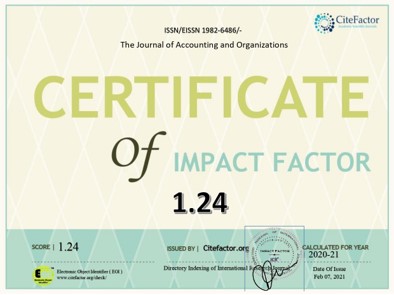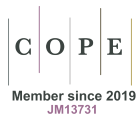Efeitos do uso dos orçamentos estático e flexível na inovação de processos e produtos
DOI:
https://doi.org/10.11606/issn.1982-6486.rco.2021.180829Palavras-chave:
Orçamento estático, Orçamento flexível, Inovação de processos, Inovação de produtosResumo
Este estudo analisa os efeitos do uso dos orçamentos estático e flexível na inovação de processos e produtos. Uma survey foi realizada com gestores de empresas beneficiadas pela Lei n° 11.196, de 21 de novembro de 2005, denominada de Lei do Bem, e obteve-se 133 respostas válidas. Para testar as hipóteses aplicou-se a modelagem de equações estruturais, por mínimos quadrados parciais. Adicionalmente, fez-se a análise de mapas de importância-desempenho. Os resultados indicam relação positiva e significativa tanto do orçamento estático como do orçamento flexível com inovação de processos e inovação de produtos. O orçamento estático apresenta maior importância em prol da inovação de processos, enquanto o orçamento flexível exibe maior importância na inovação de produtos. De maneira geral, os achados reforçam a complementaridade dos orçamentos estático e flexível em relação à inovação tecnológica. Esses resultados contribuem para a literatura de Sistemas de Controle Gerencial, em específico sobre a utilidade dos orçamentos, além de contribuições práticas para a gestão, como no caso das empresas inovadoras beneficiadas pela Lei do Bem.
Downloads
Referências
Ahrens, T., & Chapman, C.S. (2004). Accounting for flexibility and efficiency: a field study of management control systems in a restaurant chain. Contemporary Accounting Research, 21(2), 271-301. DOI: https://doi.org/10.1506/VJR6-RP75-7GUX-XH0X
Bedford, D.S. (2015). Management control systems across different modes of innovation: Implications for firm performance. Management Accounting Research, 28, 12-30. DOI: https://doi.org/10.1016/j.mar.2015.04.003
Bedford, D.S., Bisbe, J., & Sweeney, B. (2019). Performance measurement systems as generators of cognitive conflict in ambidextrous firms. Accounting, Organizations and Society, 72, 21-37. DOI: https://doi.org/10.1016/j.aos.2018.05.010
Bedford, D.S., Malmi, T., & Sandelin, M. (2016). Management control effectiveness and strategy: an empirical analysis of packages and systems. Accounting, Organizations and Society, 51, 12-28. DOI: https://doi.org/10.1016/j.aos.2016.04.002
Burns, T., & Stalker, G.M. (1961). The management of innovation. London: Tavistock.
Camisón, C., & Villar-López, A. (2014). Organizational innovation as an enabler of technological innovation capabilities and firm performance. Journal of Business Research, 67(1), 2891-2902. DOI: https://doi.org/10.1016/j.jbusres.2012.06.004
Cassar, G., & Gibson, B. (2010). Budgets, internal reports, and manager forecast accuracy. Contemporary Accounting Research 25(3), 707-737. DOI: https://doi.org/10.1506/car.25.3.3
Chenhall, R.H., & Moers, F. (2015). The role of innovation in the evolution of management accounting and its integration into management control. Accounting, Organizations and Society, 47, 1-13. DOI: https://doi.org/10.1016/j.aos.2015.10.002
Chtioui, T., & Dubuisson, S.T. (2020). Towards a communication-based typology of management control modes: showing the relevance of communicative action for entrepreneurial settings. International Journal of Entrepreneurship and Small Business, 39(1-2), 163-191. DOI: https://doi.org/10.1504/IJESB.2020.104249
Cohen, J. (1988). Statistical power analysis for the behavioral sciences (2. ed.). New York: Psychology Press.
Dal Magro, C.B., & Lavarda, C.E.F. (2015). Evidências sobre a caracterização e utilidade do orçamento empresarial nas indústrias de Santa Catarina. Advances in Scientific and Applied Accounting, 8(1), 039-062. DOI: https://doi.org/10.14392/asaa.201581039-062
Dugdale, D., & Lyne, S. (2008). Budgeting and organizational structure. Research Executive Summaries - CIMA, 6(4), 1-7.
Dunk, A.S. (2011). Product innovation, budgetary control, and the financial performance of firms. The British Accounting Review, 43(2), 102-111. DOI: https://doi.org/10.1016/j.bar.2011.02.004
Ekholm, B.G., & Wallin, J. (2000). Is the annual budget really dead? European Accounting Review, 9(4), 519-539. DOI: https://doi.org/10.1080/09638180020024007
Ekholm, B.G., & Wallin, J. (2011). The impact of uncertainty and strategy on the perceived usefulness of fixed and flexible budgets. Journal of Business Finance & Accounting, 38(1‐2), 145-164. DOI: https://doi.org/10.1111/j.1468-5957.2010.02228.x
Frow, N., Marginson, D., & Ogden, S. (2010). “Continuous” budgeting: reconciling budget flexibility with budgetary control. Accounting, Organizations and Society, 35(4), 444-461. DOI: https://doi.org/10.1016/j.aos.2009.10.003
Grabner, I., & Moers, F. (2013). Management control as a system or a package? Conceptual and empirical issues. Accounting, Organizations and Society, 38(6-7), 407-419. DOI: https://doi.org/10.1016/j.aos.2013.09.002
Gunday, G., Ulusoy, G., Kilic, K., & Alpkan, L. (2011). Effects of innovation types on firm performance. International Journal of Production Economics, 133(2), 662-676. DOI: https://doi.org/10.1016/j.ijpe.2011.05.014
Hair Jr., J.F., Hult, G.T.M., Ringle, C.M., & Sarstedt, M. (2017). A primer on partial least squares structural equation modeling (PLS-SEM) (2. ed.). Los Angeles: Sage
Hair Jr., J.F., Risher, J.J., Sarstedt, M., & Ringle, C.M. (2019). When to use and how to report the results of PLS-SEM. European Business Review, 31(1), 2-24. DOI: https://doi.org/10.1108/EBR-11-2018-0203
Hansen, S.C., Otley, D.T., & Van der Stede, W.A. (2003). Practice developments in budgeting: an overview and research perspective. Journal of Management Accounting Research, 15(1), 95-116. DOI: https://doi.org/10.2308/jmar.2003.15.1.95
Henri, J.F. (2006). Management control systems and strategy: A resource-based perspective. Accounting, Organizations and Society, 31(6), 529-558. DOI: https://doi.org/10.1016/j.aos.2005.07.001
Henri, J., Massicotte, S., & Arbour, D. (2019). Exploring the consequences of competing uses of budgets. Australian Accounting Review, 30(4), 257-268. DOI: https://doi.org/10.1111/auar.12287
Hope, J., & Fraser, R. (2003) Beyond budgeting: how managers can break free from the annual performance trap. Boston: Harvard Business School Press.
Horngren, C.T., Foster, G., & Datar, S.M. (2000). Cost accounting: a managerial emphasis. (10. ed.). New Jersey: Prentice Hall.
Khandwalla, P.N. (1972). The effect of different types of competition on the use of management controls. Journal of Accounting Research, 10(2), 275-285. DOI: https://doi.org/10.2307/2490009
Laitinen, E.K., Länsiluoto, A. & Salonen, S. (2016). Interactive budgeting, product innovation, and firm performance: empirical evidence from Finnish firms. Journal of Management Control, 27(4), 293-322. DOI: https://doi.org/10.1007/s00187-016-0237-2
Libby, T., & Lindsay, R.M. (2007). Beyond budgeting or better budgeting? Strategic Finance, 89(2), 46-51.
Lopez-Valeiras, E., Gonzalez-Sanchez, M.B., & Gomez-Conde, J. (2016). The effects of the interactive use of management control systems on process and organizational innovation. Review of Managerial Science, 10(3), 487-510. DOI: https://doi.org/10.1007/s11846-015-0165-9
Matějka, M., Merchant, K.A., & O'Grady, W. (2020). An empirical investigation of beyond budgeting practices. Journal of Management Accounting Research. In press. DOI: https://doi.org/10.2308/jmar-19-010
Mucci, D.M., Frezatti, F., & Dieng, M. (2016). The multiple functions of budgeting. Revista de Administração Contemporânea, 20(3), 283-304. DOI: https://doi.org/10.1590/1982-7849rac2016140121
Organização de Cooperação e Desenvolvimento Econômico (OCDE). (2005). Manual de Oslo: diretrizes para coleta e interpretação de dados sobre inovação (3. ed.). Brasília: FINEP.
Otley, D. (1999). Performance management: a framework for management control systems research. Management Accounting Research, 10(4), 363-382. DOI: https://doi.org/10.1006/mare.1999.0115
Pazetto, C.F., Mannes, S., & Beuren, I.M. (2020). Influência dos sistemas de controle e da folga de tempo na inovação de processos. RAM. Revista de Administração Mackenzie, 21(3), 1-27. DOI: https://doi.org/10.1590/1678-6971/eramr200147
Podsakoff, P.M., MacKenzie, S.B., Lee, J.Y., & Podsakoff, N.P. (2003). Common method biases in behavioral research: a critical review of the literature and recommended remedies. Journal of Applied Psychology, 88(5), 879. DOI: https://doi.org/10.1037/0021-9010.88.5.879
Ringle, C.M., & Sarstedt, M. (2016). Gain more insight from your PLS-SEM results. Industrial Management & Data Systems, 116(9), 1865-1886. DOI: https://doi.org/10.1108/IMDS-10-2015-0449
Samuelson, L.A. (1986). Discrepancies between the roles of budgeting. Accounting, Organizations and Society, 11(1), 35-45. DOI: https://doi.org/10.1016/0361-3682(86)90017-6
Saunila, M., & Mäkimattila, M. (2018). A dynamic learning perspective on innovation control: balancing freedom and constraint. In: Innovation and Capacity Building (pp. 273-291).
Palgrave Macmillan, Cham. DOI: https://doi.org/10.1007/978-3-319-90945-5_14
Schumpeter, J.A. (1982). Teoria do desenvolvimento econômico: uma investigação sobre lucros, capital, crédito, juro e o ciclo econômico. São Paulo: Abril Cultural.
Sponem, S., & Lambert, C. (2016). Exploring differences in budget characteristics, roles and satisfaction: a configurational approach. Management Accounting Research, 30, 47-61. DOI: https://doi.org/10.1016/j.mar.2015.11.003
Tidd, J., Bessant, K. (2015). Gestão da inovação (5. ed.). Porto Alegre: Bookman.
Van der Stede, W.A. (2000). The relationship between two consequences of budgetary controls: budgetary slack creation and managerial short-term orientation. Accounting, Organizations and Society, 25(6), 609-622. DOI: https://doi.org/10.1016/S0361-3682(99)00058-6
Downloads
Publicado
Edição
Seção
Licença
Copyright (c) 2021 Silvana Mannes, Anderson Betti Frare, Ilse Maria Beuren

Este trabalho está licenciado sob uma licença Creative Commons Attribution-NonCommercial-NoDerivatives 4.0 International License.
A RCO adota a política de Acesso Livre (Libre Open Access), sob o acordo padrão Creative Commons (CC BY-NC-ND 4.0). O acordo prevê que:
- A submissão de texto autoriza sua publicação e implica compromisso de que o mesmo material não esteja sendo submetido a outro periódico. O original é considerado definitivo;
- Autores mantêm os direitos autorais e concedem à revista o direito de primeira publicação, com o trabalho simultaneamente licenciado sob a Licença Creative Commons Attributionque permite o compartilhamento do trabalho com reconhecimento da autoria e publicação inicial nesta revista;
- Autores têm autorização para assumir contratos adicionais separadamente, para distribuição não-exclusiva da versão do trabalho publicada nesta revista (ex.: publicar em repositório institucional ou como capítulo de livro), com necessário reconhecimento de autoria e publicação inicial nesta revista;
- Autores têm permissão e são estimulados a publicar e distribuir seu trabalho online (ex.: em repositórios institucionais ou na sua página pessoal) antes ou durante o processo editorial, já que isso pode gerar alterações produtivas, bem como aumentar o impacto e a citação do trabalho publicado (Veja O Efeito do Acesso Livre);
- A revista não paga direitos autorais aos autores dos textos publicados;
- O detentor dos direitos autorais da revista, exceto os já acordados no acordo de Libre Open Access (CC BY-NC-ND 4.0), é o Departamento de Contabilidade da Faculdade de Economia, Administração e Contabilidade de Ribeirão Preto da Universidade de São Paulo.
Não são cobradas taxas de submissão ou de publicação.
São aceitos até 4 autores por artigo. Casos excepcionais devidamente justificados poderão ser analisados pelo Comitê Executivo da RCO. São considerados casos excepcionais: projetos multi-institucionais; manuscritos resultantes da colaboração de grupos de pesquisa; ou que envolvam grandes equipes para coleta de evidências, construção de dados primários e experimentos comparados.
É recomendada a ordem de autoria por contribuição, de cada um dos indivíduos listados como autores, especialmente no desenho e planejamento do projeto de pesquisa, na obtenção ou análise e interpretação de dados e redação. Os autores devem declarar as efetivas contribuições de cada autor, preenchendo a carta ao editor, logo no início da submissão, responsabilizando-se pelas informações dadas.
É permitida a troca de autores durante todo o processo de avaliação e, antes da publicação do manuscrito. Os autores devem indicar a composição e ordem final de autoria no documento assinado por todos os envolvidos no aceite para publicação. Caso a composição e ordem de autoria seja diferente da informada anteriormente no sistema, todos autores anteriormente listados deverão se manifestar favoráveis.
No caso de identificação de autoria sem mérito ou contribuição (ghost, guest or gift authorship), a RCO segue o procedimento recomendado pela COPE.







